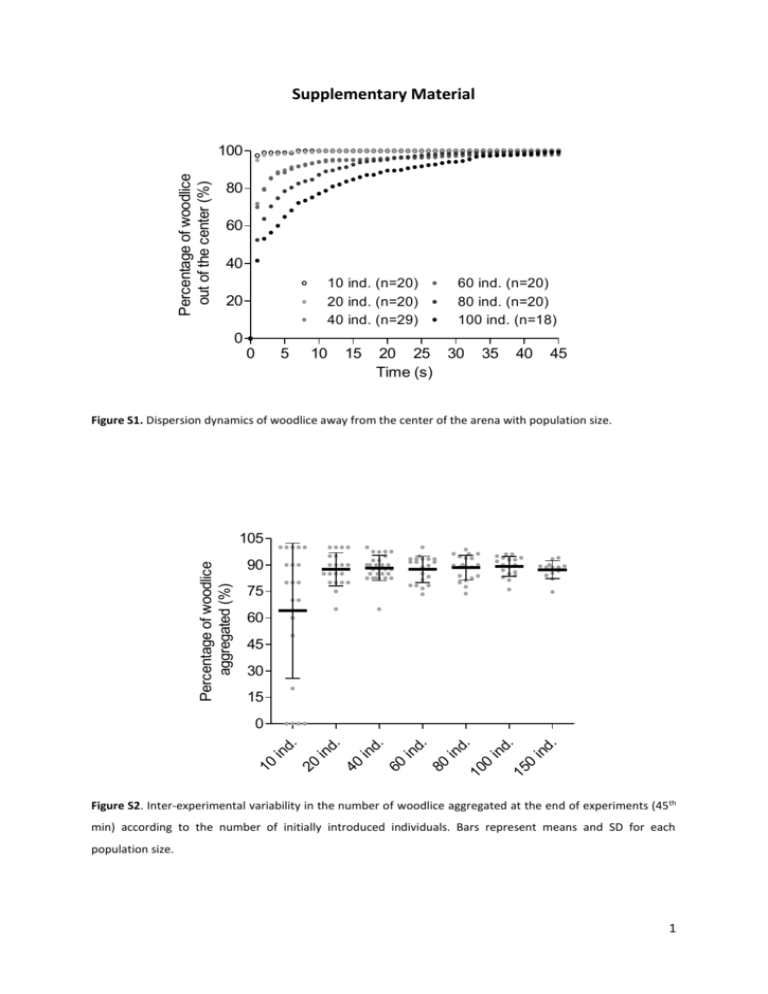Supplementary Material - Springer Static Content Server
advertisement

Supplementary Material Percentage of woodlice out of the center (%) 100 80 60 40 10 ind. (n=20) 20 ind. (n=20) 40 ind. (n=29) 20 60 ind. (n=20) 80 ind. (n=20) 100 ind. (n=18) 0 0 5 10 15 20 25 30 Time (s) 35 40 45 Figure S1. Dispersion dynamics of woodlice away from the center of the arena with population size. Percentage of woodlice aggregated (%) 105 90 75 60 45 30 15 d. in d. 15 0 in 10 0 in d. 80 in d. 60 in d. 40 in d. 20 10 in d. 0 Figure S2. Inter-experimental variability in the number of woodlice aggregated at the end of experiments (45th min) according to the number of initially introduced individuals. Bars represent means and SD for each population size. 1 Average number of secondary aggregates per experiment Average number of woodlice per secondary aggregate Average lifetime of secondary aggregates (min) 10 woodlice (n=20) 20 woodlice (n=20) 40 woodlice (n=28) 60 woodlice (n=20) 80 woodlice (n=20) 100 woodlice (n=18) 150 woodlice (n=15) 0.05 0.25 0.92 0.9 0.55 0.88 - 2 2.3 ± 0.2 4.2 ± 2.0 4.9 ± 3.0 5.0 ± 2.0 4.0 ± 1.5 - 6 13.4 ± 6.2 14.6 ± 12.8 8.1 ± 7.3 7.3 ± 5.0 6.4 ± 3.8 - Table S1. Analysis of secondary aggregates outside of the shelters. There is no difference between the number of secondary aggregates produced by population size, except for the 10 woodlice group significantly lower than the 40, 60 and 100 woodlice groups, and the 20 woodlice group significantly lower than the 60 and 100 woodlice groups (Kruskal-Wallis and Dunn test; p<0.001; KW=26.016). There is no difference between the average number of woodlice per aggregate (means ± SD), except at 20 woodlice, which differs from 60 and 80 woodlice (Kruskal-Wallis and Dunn test; p=0.0101; KW=15.070). There is a difference between the average lifetimes of the secondary aggregates (means ± SD), but the Kruskal-Wallis and Dunn post-test does not detect any pairwise differences between the groups (p=0.0165; KW=13.861). 1.0 Fraction of experiments *** 0.8 0.6 0.4 0.2 0.0 < ost M s Les > ost s Les M Figure S3. Fraction of experiments (n=56) where the final aggregate in the most-filled shelter presents a smaller length/width ratio than that in the least-filled shelter just before irreversible selection of the shelters, and vice versa. The difference between the fractions is significant (Chi-square test, p<0.0001). On average, the value of the length/width ratio of the aggregate in the most-filled shelter is 2.4 (+/- 0.96), which is significantly lower (Wilcoxon match-paired test, p= 0.0007) than that in the least-filled shelter (2.9 +/- 1.12). 2 Figure S4: Conformation of aggregates under shelters In this section, we consider the spatiotemporal conformation of the individuals aggregated under the shelters. First, the surface area of the aggregate (S) increases with the number of individuals inside (N) in accordance with the non-linear relationships of S= 0.6N0.77 (R²=0.8284) and S= 0.9N0.65 (R²=0.9413) for the most- and least-filled shelters, respectively (Fig. S4A). A one-way ANCOVA test of the logarithmic data indicates an equality between the two slopes (F=0.4706, p=0.4913) and a difference between the adjusted means of the regressions (F= 8.088, p= 0.0051). The mean fitting of the coupled data for Ln (Surface area) the most- and least-filled shelters gives the relationship: S= 0.6N0.75 (R²=0.8955). 4.0 3.5 3.0 2.5 2.0 1.5 1.0 0.5 0.0 -0.5 -1.0 -1.5 Most-filled shelter Least-filled shelter 1 2 3 4 Ln (number of individuals) 5 Figure S4A. Logarithmic relationship between the total surface area of the aggregates (cm²) and the number of individuals inside the most- or least-filled shelter at the end of the binary choice tests (45th min). All of the experimental conditions are pooled. Secondly, the measurement of surface area occupied by the aggregate under the shelter reaching the most of individuals (only under the shelter, regardless of the overflow) shows the gradual increase of the shelter filling according to the density, up to more than 90% when 100 or 150 woodlice are introduced (Fig. 5B, 6A, S4B). At this stage, we can talk of a saturation of the shelter. This saturation is counterbalanced by the increasing overflowing of the aggregate beyond limits of the shelter, reaching almost half (46%) of the total size of the aggregate with 100 and 150 woodlice (Fig. 5B, 6B, S4C). Aggregates under the most or the least filled shelter of the binary choice test present similar spatial conformation at the end of experiments. Indeed, regardless of the number of individuals, the aggregates under the both shelters present similar surface area pattern (Fig. S4A) and similar shape (i.e., with similar shelter filling (Fig. 6A, S4B) and similar shelter overflowing (Fig. 6B, S4C)). 3 Most-filled shelter C 100 Shelter overflowing (%) 80 60 40 20 Most-filled shelter 80 60 40 20 in d. d. 0 15 0 10 20 ind in . d. 40 in d. 60 in d. 80 in d. 10 0 in d. 0 Least-filled shelter in Shelter filling (%) 100 15 0 Least-filled shelter 10 20 ind in . d. 40 in d. 60 in d. 80 in d. 10 0 in d. B Figure S4B. Percentage of the most- and least-filled shelters that are filled by the aggregate (expressed as the percentage of the surface area occupied by the aggregate under the shelter at the end of the experiments) according to the number of initially introduced woodlice. The error bars represent the standard deviations. Figure S4C. Surface area of the aggregate overflowing from the most- and least-filled shelters (expressed as the percent of the total surface area of the aggregate at the end of the experiments) according to the number of initially introduced woodlice. The error bars represent the standard deviations. In addition, the surface area per individual decreases with the number of individuals in the aggregate (Fig. S4D), as demonstrated previously (Broly et al., 2014). Here, we show that the surface area per individual also decreases independently of the number of woodlice with the duration of the experiment (Fig. S4D, E). In other words, group compaction increases with both the number of conspecifics and time. The gain in compactness is of 35% between the 5 first minutes and the end of experiments (Fig. S4E). Finally, the length/width ratio of the aggregate decreases during the experiment (Fig. S4F). In other words, the aggregate first grows in length (due to the strong behavior of the woodlice to follow the edge of the arena) and then progressively grows in width, which indicates a reduction of the effect of the edge on the group and a spatiotemporal reorganization of the woodlice toward the center of the arena. This spatiotemporal compaction of the woodlice leads to a reduced surface area/volume ratio of the aggregate and therefore leads to reduce the individual exchanges with the environment as body water loss (see Broly et al. 2014). 4 E D Surface area (cm²) / Ind. Surface area (cm²) / Ind. 0.6 0.4 0.2 0.0 0 0.45 0.40 0.35 0.30 0.25 0.20 0.15 0.10 0.05 0.00 20 40 60 80 100 Number of individuals in the aggregate 0 5 10 15 20 25 30 Time (min) 35 40 45 Figure S4D. Relationship between the surface area (in cm²) per individual and the number of individuals in the aggregate, at the end of the experiments (in grey, which includes data at the 45th min from experiments with 10 to 150 ind.) or during the experiments (in black, which includes data from experiments with 100 ind. at different times). The grey scatter plot is fitted by S= 0.896N -0.3118 (R²= 0.4339), and the black scatter plot by S= 0.5099N-0.1916 (R²= 0.4026). There is a significant difference between the slopes of the two curves (one-way ANCOVA, F= 8.647, p= 0.00356). Figure S4E. Relationship between the surface area (in cm²) per individual in the aggregate and the duration of experiment (in experiments with 100 woodlice). The surface area per individual (S) decreases with time (t), following S= 0.4121t-0.1877 (R²= 0.958). The error bars represent the standard deviations. G Lenght/Width ratio 5 4 3 2 1 0 0 5 10 15 20 25 30 35 40 45 50 Time (min) Figure S4F. Schematic representation of the aggregate centered under shelter and the location of measurements. Figure S4G. Relationship between the shape of the aggregate (length/width ratio) and the duration of the experiment (in experiments with 100 woodlice). The ratio (R) decreases with time (t), according to R= 4.226t-0.1687 (R²= 0.9431). The gain in compactness is of 29% between the 5 first minutes and the end of experiments. The error bars represent the standard deviations. 5 500 10 a 10 b y= 0.1071x 400 8 400 8 300 6 300 6 200 4 200 4 100 2 100 2 0 4000 0 0 0 50 1000 2000 3000 10 c 8 40 y= 0.7213x 6 4 y= 0.1225x 2 0 150 0 160 25 50 75 100 125 10 e 140 2000 0 4000 3000 10 d 60 8 6 40 y= 0.6203x 30 4 20 10 0 70 1000 50 30 20 0 2 10 y= 0.1564x 0 0 160 8 100 6 80 50 75 100 125 150 0 175 10 f 140 120 25 8 120 100 6 80 y= 0.4112x 60 40 4 2 20 0 0 80 150 300 450 8 60 6 40 4 y= 0.1153x y= 0.5756x 2 0 0 0 50 100 150 200 2 250 300 y= 0.1360x 0 0 10 20 40 600 g 4 y= 0.3822x 20 y= 0.1204x 0 60 Number of individuals under shleter Cumulative number of entries into shelter 500 y= 0.1152x 225 200 175 150 125 100 75 50 25 0 150 0 450 300 h y= 0.5042x 10 8 y= 0.1173x 6 4 2 0 0 300 600 900 1200 1500 Cumulative number of individuals outside shelter Figure S5. Cumulative number of entries into a shelter according to the cumulative number of individuals outside shelter in two experiments without aggregation (a, b), five experiments presenting fast and stable aggregation (c, d, e, f, g), and an experiment with aggregation obtained after 30 min (h). The number of individuals aggregated in the shelter is shown by the right axis (grey points). The curve may be fit by one or two linear regression(s); the red line fits phases where mechanisms of amplification of the aggregation process are not at work, while in contrast, the blue line fits the phase where attraction occurs (increasing slopes). 6 120 a 100 80 60 0 1 2 3 4 5 6 7 8 Number of individuals 9 10 11 Figure S6. Values of parameter a in equation (6) that fit the residence time for each group size. The values of a according to the number of individuals under shelter (N) are fitted by a linear regression: a= -0.5382(±0.4345)N + 103.6(±2.696) (r²= 0.1610). An F test on the linear regression indicates the slope for a does not deviate from zero (F=1.535, p=0.2505). 7






